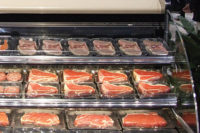Technicians servicing refrigeration systems need to be knowledgeable in several different trades, one of which is plumbing. Since evaporators typically operate below the dew point temperature of the entering air, water vapor will condense out of the air and onto the evaporator’s surface. This water must then be safely drained away. Removal of this water is part of the basic design of any refrigeration system. Typically a drain line is connected to a drain pan located on the bottom of the evaporator’s housing.
The installation of this drain line is an important part of the operation of the system. Improperly installed drain lines can cause water to leak from the evaporator, potentially leading to product damage (as in the case of a walk-in cooler or freezer). This water can leak onto the product stored within the cabinet and possibly damage it. It can also be a slip hazard for anyone working in the cooler or freezer.
Following a few basic guidelines will help ensure that this water is properly drained away from the evaporator. First, it is recommended that copper or steel drain lines be used instead of plastic lines. Also, the diameter of the drain line pipe should be at least the same diameter as the connection provided on the evaporator’s drain pan.
The pitch of these drain lines is also an important part of the overall installation. It is generally recommended that the horizontal section of pipe have a pitch of at least 4 inches per linear foot. This will be adequate to drain the water away from the evaporator and prevent it from draining too slowly or standing in the line.
Drain lines should be run to an open drain and never be connected directly to a sewer system. This will prevent sewage from backing up into the evaporator in the event the sewage system backs up.
Drain lines that run outdoors, or in areas where freezing may occur (such as in a walk-in freezer), must be heated to prevent refreezing of the water as it drains away. These lines should also be insulated to prevent heat loss. Electric resistive heaters are typically used. Drain lines exposed to ambient temperatures of 0°F should use a 20â€'W per linear foot heater. Drain lines exposed to ambient temperatures of -20° should use a 30â€'W per linear foot heater. Also, these heaters should be wired so that they are energized all the time.
Traps in the drain lines are also important for a successful installation. Traps help prevent warm air from entering the refrigerated case. If multiple drain lines are connected to a common drain line, a trap should be placed in each individual drain line before any teed connection. As with the installation of any refrigeration component, remember to follow the manufacturer’s recommendations. Also, remember to follow any local plumbing codes. The installation of condensate drain lines is not a difficult process. If done correctly, they help ensure that the water is safely drained away from the evaporator.
Publication Date:06/02/2008
Copyright ©2025. All Rights Reserved BNP Media.
Design, CMS, Hosting & Web Development :: ePublishing






